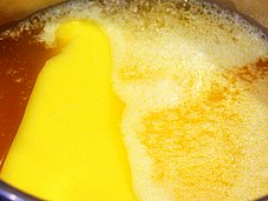Ghee – This Is Butter That Is Good for You
By Kiva Bottero | Ноя 25, 2011

To some it’s known as clarified butter, to others it’s the golden elixir of healing – ghee is a staple ingredient in Indian cooking and Ayurvedic healing known for its versatility, great taste, and many health benefits. It’s derived from butter through a process of cooking off its milk solids until it becomes an easily digestible, healthier alternative to butter and oil, and it can be used for cooking or as an ingredient to add flavor and richness to foods such as kitchari.
Cooking benefits
Excellent cooking oil – Since ghee doesn’t start smoking until it’s heated to 375 degrees Fahrenheit, it will neither burn nor splatter easily. Its chemical structure also remains more stable than other oils when heated.
Stores well – Thanks to its low moisture content, ghee can go weeks without refrigeration. It can last up to six months in the fridge or one year in the freezer, according to the Ayurvedic Institute. The key to ghee longevity: store it somewhere cool, keep it covered, and make sure it doesn’t get contaminated by other liquids – don’t double dip!
Flavorful – Thanks to its strong flavor, not much ghee needs to be added to a dish to make it sing.
Health benefits
Easily digestible – The process of cooking off milk solids from butter burns off its lactose and cholesterol (says Holistic Chef Shani Cranston of hOMe Grown Living Foods). This makes it much easier to digest than butter or vegetable oils.
Anti-inflammatory – According to the Sushruta Samhita, a text of the ancient Indian healing system of Ayurveda, ghee is the ultimate anti-inflammatory food.
Whole body healing – Ayurvedic practitioners use the golden elixir for everything from rejuvenating skin to aiding digestion to balancing hormones.
Flexibility – Dr. Vasant Lad, founder and director of the Ayurvedic Institute, explains ghee’s popularity among yogis by stating that it lubricates connective tissues and makes the body more flexible.
Enhances your essence – As reported by Paul Pitchford in Healing with Whole Foods: Asian Traditions and Modern Nutrition, ghee boosts ojas, the underlying essence of body issues; this leads to an increased immune system and greater longevity.
Increases agni – In Ayurveda, proper digestion revolves around agni, the body’s digestive fire. Consuming ghee boosts one’s agni, leading to better digestion and faster metabolism.
Butter’s yummy richness adds to many a dish, yet its unhealthiness prevents people from using it. Though it still has a high fat content, ghee’s many health benefits make it a fine alternative to butter or oil that you can make yourself. See below for detailed directions from Holistic Chef Shani Cranston:
Ghee
Makes 2 cups
1. Melt 1 pound of unsalted butter in a heavy saucepan over medium heat. Add 3 or 4 cloves if you wish. This will aid in the clarification and lend a delicate flavor.
2. As soon as the butter begins to boil and foam, reduce the heat to a simmer. Keep the melted butter at a steady simmer until it is golden in color and no foam remains on top.
3. When the crackling sound stops, the ghee is ready.
4. Cool the mixture and strain it into a sterile quart jar. Discard the curds from the bottom, as they are almost pure cholesterol.
References:
The Ayurvedic Institute (http://www.ayurveda.com)
hOMe Grown Living Foods (http://www.hOMegrownlivingfoods.ca)
Yoga Journal: To Ghee or Not to Ghee (http://www.yogajournal.com/health/9…)
Paul Pitchford, Healing with Whole Foods: Asian Traditions and Modern Nutrition (Berkeley: North Atlantic Books, 2003)
About the author: Kiva Bottero works with a collective to publish The Mindful Word journal of engaged living (www.themindfulword.org). He also writes and edits for Dew Media, a company that specializes in providing custom publishing services for non-profits and social enterprises (www.dewmedia.org), as well as various magazines and blogs, such as Cleantech Authority (www.cleantechauthority.com).















